yen the mails go y container now
Page 41

Page 42

If you've noticed an error in this article please click here to report it so we can fix it.
f0 R VIEW of the Post Mi e is probably like mine Ise • to be. All very parochial Ind mall, with little red vans, 'ilia boxes, postmistresses, nd ootsore postmen.
T e best we can do when in ing of it as a bulk transort operator is to conjure up pi ture of overnight steam rai s with mobile sorting ffi es, in the mould of John irie son's Night Mail doculen ary.
T at is all very cosy, very )nt ntic, and very wrong by )cla 's standard, as I discov red when I visited the Post e's vast premises at Caning Town, in East London. her, in the midst of industrial nd are the combined London ve .eas Mail Office (LOMO) Id the East London Parcel on entration Office (ELPC0). "I is a totally different con)pt in postal work," says Arlo ames, superintendent at e ondon Post Office's trans)rt ection.
F r one thing, you just won't Id any little red vans at either )MS or ELPCO, but instead 3, 2, and 32-ton articulated its all geared to handle mail bu k.
T ere are 15 Guy Big J 32nn rs which run coupled to it c ntainer trailers on regular iul between LOMO and )uthampton and Thames ,ck . Many of these work daily ni htly schedules.
It's all part of the world-wide shipping revolution which has seen a change from loose cargo handling to containerisation over the last 15 years Now, instead of being transported in bags as general cargo. most surface mail is shipped in the same ISO containers which are used for general goods.
The only overseas mail which travels in the Post Office's own ISO containers is European mail on ro-ro services via Calais and Ostend. Otherwise, Britain and the other countries in the Geneva-based Universal Postal Union use shipping lines' boxes for international traffic.
While I was at Canning Town, LOMO was handling containers from such widelyknown shippers as Ellerrnan Harrison Line, Dart Line, Ben Line, and Overseas Containers. They brought in mail from West Germany, Israel, New Zealand, the United States, Australia, and Poland for delivery in this country.
In turn, they were scheduled for quick turnaround with British mail going abroad.
These containers hold as many as 1,000 mailbags, but, except in unusual circumstances, are able to be emptied within a day of arrival at LOMO.
The system for handling the mailbags is as far removed from the village post office image as anything you'll find. They are lifted from the container by overhead conveyor pulleys, taken into the sorting area, and returned for distribution aided by a pre-set coding system which ensures the bag is dropped at the correct loading platform.
LOMO is also the British end of international road freight traffic in mail, with daily services leaving for the Ostend and Calais ro-ro ferries. With these, the British tractive unit and driver remain on this side of the Channel, but the trailer continues to the French and Belgian ports for unloading there. Some traffic might never travel by container, especially to some Far Eastern countries where low labour costs make investment in expensive container handling equipment seem wasteful. However, shipping companies have not ruled out the possibility of their use in the foreseeable future.
Non-container traffic is also handled at LOMO, travelling in loose bags to the docks, but in smaller vans which also do local distribution work.
For the staff at LOMO, regular daily and weekly loads of mail are no great problem. The real test comes when a ship is due to sail to places like Ascen sion, St Helena, or the Falkland Islands on one of its occasional voyages. Miss that, and they'll be very unpopular!
This demands close liaison with the shipping firms, ensuring that goods are ready for the ship's departure. As LOMO garage inspector Sam Taylor told me. -We're no longer in a place of our own; we've got to have very good liaison with outside firms."
Work at LOMO has changed considerably since Britain joined the European Economic Community. Now, with claims of shops selling German butter, the invoices and other correspondence for such sales are being handled by the Post Office, and that means more cross-Channel traffic.
By now, LOMO is getting its teeth sunk deply into the Christmas rush, with final dates for surface mail to Australia, New Zealand, and Far Eastern
countries falling early next month. "You don't think of July in terms of Christmas,'' says schedules officer Danny Shepherd, "but we have to.
ELPCO is the Post Office's answer to the 1960s Beeching cuts which reduced the East Anglian rail network to such an extent as to make road haulage more worthwhile for parcel distribution.
All parcels for a 150-mile radious from Canning Town into East Anglia are handled through ELPCO, some of them making what seems superficially to be a double journey. A parcel could start in Chelmsford, come to ELPCO, and go back out to Witham or Colchester.
Again, articulated units handle much of the traffic, run ning from parcel depots at Norwich and Peterborough into ELPCO, where smaller Bedford TK rigids undertake break-bulk work.
Within these vehicles, parcels are carried in -mates-, box-like mini-containers on wheels, which can be handled easily by the part-time drivers
who also serve as sorting personnel at ELPCO.
While railways no longer handle the bulk of parcel traffic, the Post Office is one of Freightliners Ltd's most consistent customers for long-haul parcels' traffic. Containers are loaded at ELPCO and other parcel depots and travel through Freightliner terminals at Stratford (for Cardiff and Newcastle) and Willesden (for Edinburgh and Glasgow). In turn, the goods are distributed from similar parcel concentration offices in the four cities.
The three Post Office officials with whom I spoke were all satisfied with the Freightliners service and were confident that Scottish parcels collected in London on a Wednesday would arrive at their destination by the Friday of the same week.
Tail lifts are fitted to the Post Office's rigid vans and to its Tautliner trailers, to speed the loading and unloading of "mates". This is not so necessary at such a well equipped depot as Canning Town where vehicles are reversed against loading platforms, but is invaluable at smaller depots which are visited in the course of a day.
Trailers and "mates" tend, like many in a national network, to end up at the "wrongend of the country, so the Post Office conducts a daily "mate"' and weekly trailer check nationally to establish their whereabouts. Trailers are not sent home empty, but when Dip plating tests are due, the vehicle is worked back to its base with available traffic.
The Post Office computerises its vehicle operating schedules, using a data processing centre at St Albans to which material prepared at its London regional headquarters in Old Street is sent.
It is Post Office policy to buy only British vehicles, hence the 16 Guy Big Js, which have both Rolls-Royce and Cummins diesels. The 22-ton artics are Ford D-Series with turbocharged engines and Scottishbuilt Leylands. All of the 16tonners are based on Bedford TK chassis.
Railways seem certain to remain an important part of the Post Office's mail operations, but an efficient road haulage service, co-ordinated with rail freight, is a key to its successful and continued operation.
• ALAN MILLAR
























































































































